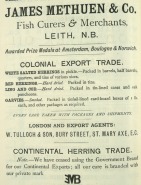Herring Home | Sale and Processing of herring | Next
Herring Export
Herring has been eaten in Scotland for hundreds of years. It was either eaten fresh or cured. Scottish herring started to be exported in the 19th century. To begin with, the Government provided bounties to encouraged fishermen to fish for herring. Bounties were stopped in the 1830s, but exports continued to grow. In the early 19th century, herring was exported mainly to Ireland and the West Indies. These were both territories under British control. In the West Indies, it was fed to the slaves. These places were less fussy about quality than in Europe. Slavery was abolished in the 1830s and in the 1840s there was a huge Potato Famine in Ireland. After this, the markets moved to Germany, Russia and Poland.

Until the mid 19th century, the Dutch dominated the market. They had a reputation for producing high quality fish. Early in the century, fishery officers were introduced in Scotland. They helped to improve the system of herring curing. There was more emphasis on quality and crown branding was introduced. Scotland began to dominate the market. By 1840, the crown brand was an accepted mark of quality. The Scots developed two advantages. Firstly, they cured herring onshore (whereas the Dutch cured at sea and had to repack). This led to a brighter looking fish. Secondly, the Scots brought their fish straight back to shore (compared with the Dutch who stayed at sea in the herring busses for several weeks). The Scots could therefore get their fish onto the market more quickly.
In the second half of the 19th century, more fish was exported to Europe. There were improvements in transport by river, canal and railway. These made export easier and increased the size of market. By the late 19th century about two million barrels of herring were consumed annually.
There were big economic changes during the twentieth century. These worked against the herring fishery. At the beginning of the century over a million barrels of herring were being consumed annually. After the First World War, disaster struck. German and Russia had major internal problems and so these export markets collapsed. British industries were also doing badly, in particular coalmining. This had a knock-on effect for the fishing industry. The industry was now catching more than it could sell. There was also an increase in competition. Iceland and Germany joining the established competitors of Norway and Holland. The Scottish herring curing industry was highly labour-intensive. It was becoming very difficult for them to compete.